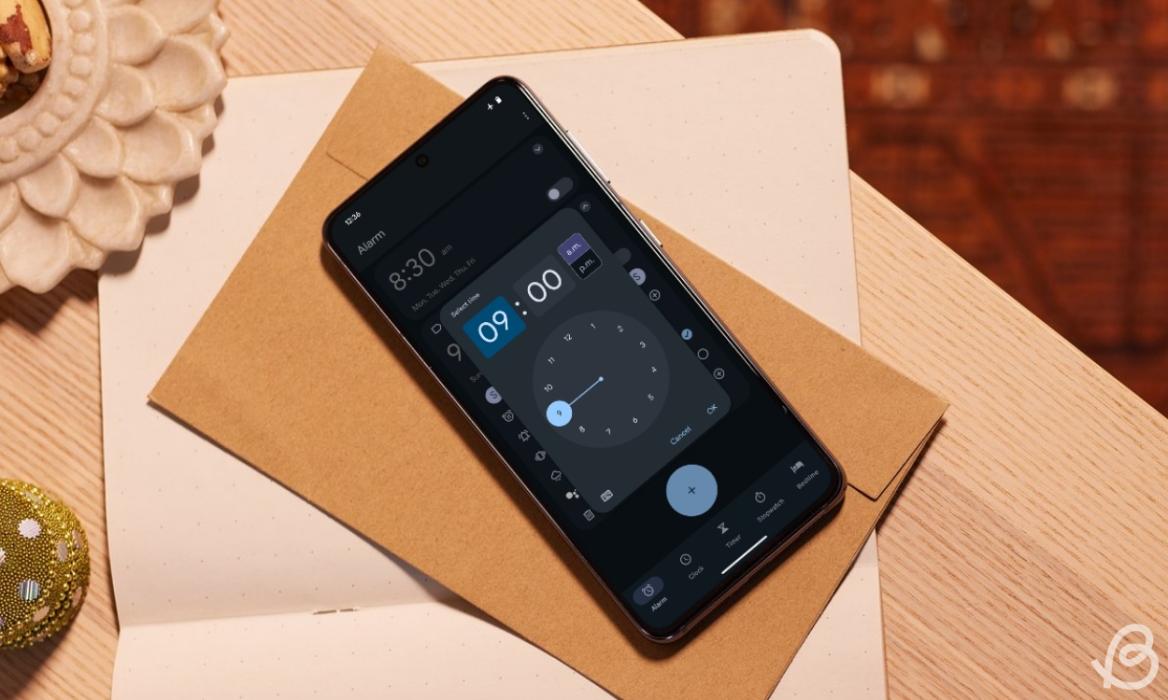Google’s Android Clock app is undergoing a notable visual and interaction refresh connected to Google’s Material 3 Expressive initiative. Leaked screenshots provide the first concrete glimpse of how the stock Clock app on Android could look once the broader Material 3 Expressive redesign takes hold. The previews show a clock-focused UI that departs from the familiar Material You style in favor of new typographic choices, a reshaped bottom toolbar, and a set of layout updates across the Clock, Timers, and Stopwatch sections. The revelations come via screenshots shared by Mystic Leaks, giving us a clear sense of where Google might be steering the Clock experience as part of Android 16’s development cycle. The images depict a Clock tab renamed to World Clock, a substantially reworked Alarms page, and other notable changes that suggest a wider design language shift for Google’s core apps.
Material 3 Expressive: A New Direction for Android UI
Material 3 Expressive represents an ambitious step in Google’s ongoing evolution of its design system, with a focus on stronger typography, bolder shapes, and a more expressive use of space and motion. In the context of Android 16, this initiative appears to be shaping not only the broader aesthetic language but also the concrete UI components that users interact with on a daily basis. The screenshots point to a redesigned UI that prioritizes clarity and prominence for key controls, while reimagining how information and actions are presented in the Clock family of features.
A central implication of Material 3 Expressive is the rethinking of how surfaces, shapes, and typography work together to convey hierarchy. In the leaked Clock app visuals, Google experiments with a thicker, more assertive font treatment and a shift away from some of the softer, more rounded cues that characterized earlier Material You designs. This is not merely a cosmetic overhaul; it signals a broader intent to make primary actions more visually accessible and to streamline user workflows by aligning typography, spacing, and control affordances in a more pronounced manner. The Clock app, with its arrays of timers, alarms, and timekeeping tools, serves as a high-signal canvas for testing how expressive typography and more pronounced shapes impact readability, speed of use, and perceived system-wide consistency. While the changes are clearly in early development stages, the direction underscores Google’s aim to unify the look and feel of core apps under a more distinctive Material 3 Expressive identity as Android 16 looms.
From a strategic perspective, the shift toward Material 3 Expressive in the Clock app also highlights a desire for greater visual cohesion across Google’s software ecosystem. If this design language is intended to thread through Calendar, Clock, Photos, and other stock apps, the Clock’s visual updates provide a microcosm of the broader transformation. The emphasis on a reimagined UI that retains essential functionality while adopting a more assertive visual language could pave the way for a unified aesthetic standard across Android’s native experiences. In addition, early-stage changes like these often precede more sweeping updates in typography, motion, and component behavior across system apps, signaling how Google plans to roll out Material 3 Expressive across the Android platform.
However, it’s important to treat these visuals as preliminary. The Clock app design shown in the leaks is at a very early stage of development, and there may be shifts in typography, spacing, iconography, and interaction patterns before the final release. The distinct shapes and layout decisions observed in these screenshots—such as the new bottom toolbar and the elongated time selectors—could evolve significantly as Google tests usability and refinement criteria with real users and devices. The public reception to this phase of design exploration will likely influence subsequent iterations of Material 3 Expressive as Google weighs consistency against expressive flexibility.
The role of leaks in the design conversation
Leaks offer a valuable, if imperfect, window into what engineers and designers are exploring. They provide real-world cues about how Google is testing the balance between familiarity and novelty within a stock Android experience. The Clock app’s leak-based preview reinforces a broader narrative: Android 16 is shaping up to be a platform where Google experiments with more pronounced, screen-filling controls and a typography-driven hierarchy that could affect how users approach time and scheduling tasks. Yet leaks also carry the risk of exposing features before final polish, which can lead to mixed reception if early design decisions appear inconsistent with other system or third-party apps. As such, the Clock redesign in Material 3 Expressive should be viewed as a snapshot of ongoing exploration rather than a definitive blueprint for Android 16’s UI.
Clock App Redesign: Detailed Look at the Screenshots
The screenshots shared by Mystic Leaks present a concrete set of changes to the Clock app, illustrating how the new design language translates into tangible UI elements. The most visible alterations begin with the Clock tab, which has been renamed to World Clock, signaling a shift in terminology and focus for the app’s primary navigation surface. The World Clock label communicates a clear scoping of the clocking experience, placing a premium on international time awareness and a streamlined approach to multiple time zones. This rename, while seemingly small, aligns with a broader trend toward more explicit labeling in Material 3 Expressive, contributing to improved discoverability for users navigating across clocks and alarms.
The Alarms page overhaul
A major component of the redesign centers on the Alarms page, described as receiving a “major overhaul.” The new layout features a floating action button (FAB) that has adopted a squircle shape and has been repositioned to the right side of the interface. The repositioning of the FAB is notable, as it reflects a shift toward more accessible action placement, aligning with contemporary design patterns that favor thumb reachability and quick access to primary actions.
When users activate the alarm-creation or alarm-edit flow, the interface now presents a sheet that departs from the traditional analog clock time picker. Instead, the time selection is presented as an elongated time selector, a visual element that stretches horizontally to accommodate more precise input and to align with the denser layout of the new UI. In addition to the time input, the sheet includes a suite of alarm customization options: Alarm name, Sound, Vibrate, Weather forecast, and Google Assistant Routine. These fields illustrate a move toward consolidating critical alarm configuration within a single, streamlined sheet, reducing navigation steps and enabling quicker setup and edits.
This redesigned Alarms sheet emphasizes a more data-rich, decision-ready interface. The elongated time selector suggests a deliberate choice to favor precision and visibility over the more compact, circular time input that characterized older clock interfaces. The inclusion of Weather forecast as a setting within the alarm flow also hints at deeper integration with ambient and contextual information, potentially enabling smarter routines or notifications based on predicted conditions or user preferences. The presence of a Google Assistant Routine option reinforces the intent to leverage automation and voice-driven actions directly from the alarm configuration context.
Timers and Stopwatch: uniform macro-shifts
The Timers tab mirrors the Alarms changes in its own way, adopting elongated time selectors in place of previous controls. The user experience for setting the duration of a timer becomes more expansive and visually aligned with the new input approach, potentially reducing entry errors and promoting a more deliberate configuration. In addition to the time selector, the Timers interface replaces the familiar play icon with a rounder rectangular “Start” button, signaling a clearer, more explicit primary action. The font used in these components also thickens, contributing to a stronger typographic presence and enhanced legibility.
As for the Stopwatch tab, the redesign moves away from the previous circular aesthetic toward a more "cubicle" or boxy look. This marks a meaningful visual break from the prior design language, suggesting a broader attempt to expand the vocabulary of shapes across the Clock app. The shift away from circular motifs toward angular or straight-edged forms continues the Material 3 Expressive trend of varied shapes and stronger geometry, while raising questions about consistency with other clock-related interfaces within Android.
Bedtime mode: stability amid change
Bedtime mode, at least in the leaked visuals, remains largely similar to the current version. This corridor of the Clock app appears to have retained its core structure and functionality, suggesting that Google may choose a more conservative approach for certain features while applying more radical changes to others. The selective modernization—where some sections receive a high-degree of reimagining while others hold to familiar layouts—reflects a phased strategy. This approach can help balance the desire for a cohesive Material 3 Expressive identity with the risks of widespread disruption to a widely used clocking experience.
A note on consistency and early-stage design
Taken together, these changes reveal a Clock app that is decisively moving away from the familiar rounded motifs that characterized Material You. The new direction introduces a boxier, more structured aesthetic, with elongated input controls and a more pronounced typographic signature. The divergent use of shapes—some elements remaining circular while others take on squared or squircle forms—points to an iterative exploration of what feels most usable and visually coherent in practice. The design’s early nature means adjustments are likely as Google tests the UI’s clarity, touch targets, legibility, and cognitive load across different screen sizes and hardware capabilities. The Clock app’s redesign is, in essence, a live blueprint for how Material 3 Expressive could manifest in stock Android features and interfaces moving forward.
Design Language and Aesthetics: From Material U to Expressive
The visual and interaction shifts in the Clock app illuminate a broader design conversation about how Google intends to balance familiarity with experimentation under Material 3 Expressive. The move from Material You’s often soft, rounded interfaces toward a mix of boxy and rounded shapes marks a deliberate exploration of how shape language communicates affordances and hierarchy. The squircle-shaped floating action button, for instance, sits at the crossroads of circular and square geometries, delivering a visually distinct control that remains immediately recognizable as a primary action. Its right-side placement indicates a prioritization of reachability and quick access, reinforcing a usability pattern that’s attuned to the thumb’s natural movement on many devices.
Typography plays a central role in this design pivot. The leaked screenshots indicate a thicker, bolder font treatment across the Clock app’s new UI panels. This typographic strategy enhances legibility, especially on small device screens where users perform time-related tasks frequently. A heavier typeface also communicates a stronger information hierarchy—alarm names, time values, and status indicators—through more noticeable weight contrasts. The combination of heftier text and more pronounced shapes contributes to a UI identity that feels more assertive, contemporary, and in line with a future-facing Material 3 Expressive approach.
The elongated time selectors observed in the Alarms sheet and Timers section reflect a broader trend toward longer input controls. This design choice can improve precision by reducing the likelihood of selecting the wrong time value, particularly when using small on-screen targets. However, it also increases the horizontal footprint of those controls, which may raise concerns about density and alignment with other on-screen elements. The net effect is a more scanning, information-rich interface that expects users to engage with longer, more deliberate interactions.
Another notable aesthetic shift is the replacement of the traditional circular time picker and standard play icon with a Start button in a rounded rectangle form. These changes signal a broader movement away from strictly circular controls toward shapes that can be more legible and touch-friendly across a variety of contexts. The updated stopwatch design—moving away from a pure circular appearance toward a boxier facade—adds to the sense that Material 3 Expressive is encouraging a mix of geometric forms rather than a single, uniform motif. While some users may welcome the refreshed look, others may perceive the transition as uneven if not accompanied by thorough consistency across all system apps.
The Bedtime mode’s relative preservation suggests that Google is calibrating which features receive the full design refresh and which are retained for familiarity and reliability. This selective modernization approach can help ground users in essential functionality while still showcasing the overarching Material 3 Expressive vision. It also raises questions about how Google will harmonize changes across the rest of the Android OS and third-party apps, where inconsistent adoption of new shapes and typographic treatments could affect the perceived coherence of the platform’s design language.
Consistency and the design system challenge
A recurring theme in early-stage Material 3 Expressive tests is the tension between a coherent brand identity and the practicalities of app-by-app variation. When a core app like Clock introduces a bold mix of shapes and typographic styles, it can set expectations that other stock apps will follow suit. If those expectations are not met across the Android ecosystem, users might experience a fragmented sense of design, which can undermine the intended unity of Material Design. Google’s challenge is to achieve a balance where expressive typography and varied shapes enhance usability without eroding predictability or cross-app familiarity.
The current leaks also illustrate that Google is still navigating which elements should be universal and which can be nuanced to fit the specific function of a given app. The World Clock renaming, the Alarms sheet’s elongated selectors, and the Start button’s new geometry all contribute to a distinct Clock identity within the Material 3 Expressive framework. Whether these elements become consistent across System UI, Google apps, and third-party offerings remains to be seen. The early-stage nature of these designs suggests that Google will continue to refine shapes, spacing, and alignment to reduce cognitive load while preserving the expressive identity that Material 3 Expressive promises.
Usability, Accessibility, and User Experience Considerations
The Clock app’s evolving design holds meaningful implications for usability and accessibility. On one hand, the stronger typography and clearer action cues can improve readability and speed, especially for users who rely on crisp text and unambiguous controls during time-critical tasks like setting alarms or starting a timer. The elongated time selectors may help users input precise times with fewer mis-taps, which is particularly beneficial on smaller screens or when using touch with one hand. The right-aligned FAB placement can facilitate quick access to alarm creation, aligning with ergonomic patterns that favor thumb reach on the most commonly used devices.
On the other hand, the shift toward larger input elements and more substantial controls could affect how information is density-packed on the screen. Users with smaller devices or those who prefer compact denser layouts may perceive the new approach as occupying too much space, potentially reducing the number of on-screen options visible at once. The boxier stopwatch and other angular components could alter how users scan and interpret information, depending on their familiarity with prior Clock app designs. Ensuring high contrast, legibility, and sufficient hit targets remains essential as the UI moves toward a more expressive shape language.
Accessibility considerations extend beyond font weight and control size. The new UI must preserve or enhance voice access and screen-reader compatibility, particularly given the deeper integration of features like Weather forecast and Google Assistant Routine within the Alarms sheet. For users who depend on assistive technologies, the updated layout should preserve logical order in the interface, ensure proper labeling of controls, and maintain predictable navigation flows as users move through the alarm setup process, timer configuration, and stopwatch operations. The introduction of elongated time selectors also invites careful testing to ensure that time input remains easily adjustable via both touch and keyboard or other input methods in devices that support accessibility features.
Additionally, the inclusion of Weather forecast as part of the alarm configuration introduces a broader context for alarms, potentially enabling location-based or weather-aware routines. While this can enhance automation and personalization, it also raises privacy and data-use considerations. If such features rely on location services or cloud-enabled routines, users should have clear, easily accessible controls to manage permissions and data sharing. The design must balance the desire for richer, context-aware functionalities with a commitment to transparent privacy settings and straightforward opt-out options.
Practical implications for daily use
From a practical standpoint, the Clock app’s redesign could influence how users approach routine management. The consolidated sheet for alarm settings, paired with a prominent Start button and the revised time input, might streamline the process of creating or editing alarms, thereby reducing the cognitive overhead associated with multiple screens or taps. The World Clock framing could encourage users to manage multiple time zones more efficiently, reinforcing the Clock app’s role as a global timekeeping tool rather than a simple alarm clock. This repositioning has the potential to improve efficiency for travelers, remote workers, and global teams who rely on precise, quickly accessible time information.
However, the real-world impact of these changes hinges on consistent implementation across devices and app ecosystems. If Android 16 ships with a broader Material 3 Expressive refresh but other system components, including third-party apps, lag in adoption or implement variations, the overall user experience could feel inconsistent. developers will need to adapt their apps to fit the new visual language, while users will weigh whether the Clock’s new design makes timekeeping easier or introduces a period of adjustment. The early-stage nature of the leaks means these outcomes are still uncertain, and ongoing iterations will determine how impactful the Clock redesign will be in practice.
Implications for Android 16 and Material Design 3 Adoption
The Clock app’s Material 3 Expressive-inspired redesign offers a microcosm of what could unfold across Android 16 and Google’s broader Material Design strategy. If the Clock changes prove effective in real-world usage, they could influence how Google applies the Material 3 Expressive language across system apps and services. The emphasis on typography, shape variety, and a more explicit action hierarchy could serve as a template for future Android UI refinements, signaling a more expressive but functionally refined direction for Google’s native apps.
Nevertheless, the early-stage nature of the design means there is ample room for refinement. The observed inconsistencies—such as the mixed use of circular and boxy shapes—underscore that Google is still calibrating the exact balance between expressive freedom and consistent visual identity. As Android 16 evolves, Google’s design teams will likely prioritize a cohesive framework that aligns with shared interaction patterns, navigation paradigms, and accessibility standards. The goal would be to deliver a unified Material Design experience that preserves the distinct personality of each app while reinforcing a clear, recognizable Android-wide design language.
Industry observers will watch how this Clock redesign aligns with other Material 3 Expressive experiments in Google’s portfolio. If multiple apps begin adopting similar elongated time selectors, more prominent typography, and refined action surfaces, users may begin to experience a more predictable and coherent aesthetic across default Android experiences. Conversely, if the Clock’s approach is not harmonized with adjacent apps or system components, it could lead to a perception of fragmented UI identity within Android 16’s launch slate. The outcome will depend on how Google orchestrates cross-app consistency, developer guidance, and iterative testing across devices and user groups.
The path forward for developers and users
For developers and users, these leaks offer a preview of what could become standard elements in the near future. Developers may anticipate standardized components and interaction patterns that reflect Material 3 Expressive principles, including more expressive typography, diverse shape vocabularies, and time-based input controls that are easier to use and customize. For users, the Clock app’s new look promises a more modern, legible, and potentially more efficient experience when setting alarms, timing events, or checking multiple time zones. Yet it also signals that there may be a transition period during which users adapt to new shapes, densities, and input modalities.
Conclusion
The early glimpses of Android’s Clock app under Material 3 Expressive reveal a decisive shift in Google’s approach to core UI elements within Android 16. A renamed World Clock tab, a reimagined Alarms screen with a squircle floating action button, and an elevated emphasis on elongated time selectors, thicker typography, and bolder shapes all point to a broader drive toward a more expressive, modern design language. The Clock app’s redesign signals Google’s intention to unify aesthetic identity across system apps while pushing for improved usability and clearer action cues. At the same time, the changes raise questions about consistency and the practical implications of a mixed shape language as Google experiments with how best to deploy Material Design 3 Expressive at scale.
As this design exploration continues, readers and users will be watching closely to see how the Clock’s updates settle in, how other stock apps respond, and whether these early moves translate into a cohesive, universal Android 16 design language or a more nuanced, app-by-app evolution. The Clock app’s evolution serves as a telling indicator of Google’s broader design ambitions and the potential trajectory of Material Design in the Android ecosystem. What remains clear is that Google is using the Clock UI as a proving ground for Material 3 Expressive concepts, testing how typography, shapes, space, and interaction work together to deliver a faster, clearer, and more visually distinctive timekeeping experience on Android.





